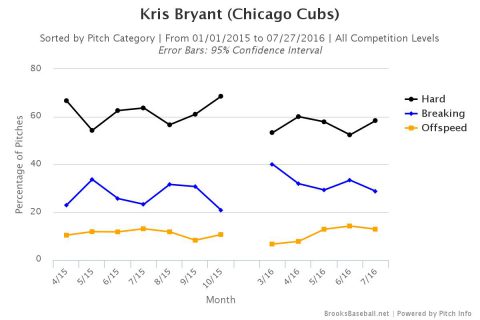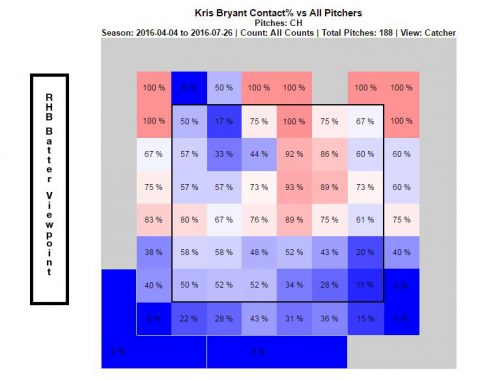Kris Bryant’s Apparent Struggles vs. Offspeed Pitches
As surprising as it may seem, given his immense success in his less than two years at the Major League level, Kris Bryant has come a long way as an offensive player. He’s cut down on his strikeouts. He’s improved his contact rate. These developments have helped to culminate in his status as the top position player in the National League thus far in 2016, according to WAR. But as we saw against James Shields on Tuesday night, which always seems to be the case when the two players meet, there are still some respects in which Bryant could stand to improve.
Now, given where my Major League sympathies lie and the undeniable success that Bryant has experienced in such a short time, it should remain relatively apparent that none of this is meant to disparage the Chicago Cubs third sacker in any sort of manner. And even if one wanted to do so, it’d be very difficult. He’s cut down on his strikeout rate by about seven percent (down to 23.3%, with a decreased swinging strike rate of 13.9%). His overall contact rate is up about five percent (to 71.4%). He’s sporting a .261 ISO. There’s not much of anything to dislike, and that’s just in regard to his offensive game.
But what was abundantly clear on Tuesday night, as Bryant served as the team’s designated hitter, was that he still struggles against the offspeed stuff. In striking out three times against James Shields, just as he did in his Major League debut, Bryant found himself peppered with changeups from the veteran hurler, as he fell to just 1-for-10 with seven punchouts against him in his short career. The goal here is to simply illustrate Kris Bryant’s battle against the offspeed pitches that Shields registered so much success with on Tuesday.
It isn’t that Bryant’s struggles have been magnified beyond that game on Tuesday on the South Side. But it did help to spark acknowledgement of what he has turned in against offspeed pitches throughout his time at the Major League level. The following represent the distribution of pitches that Bryant has seen, swung, and whiffed, respectively:



As is typically the case, offspeed pitches represent the lowest percentage of pitch type that Bryant has seen. And with the exception of an outlier of a month or two over the course of the last two seasons, his swing trends have been relatively consistent in a general sense, regardless of pitch type. Even with those ideas in mind, offspeed pitches have represented the largest percentage of pitches at which he’s swung and missed on a fairly consistent basis.
An additional trio of graphs helps to further illustrate Bryant’s issues with the offspeed stuff, specifically changeups, based off of Tuesday night:



Again, while the percentage isn’t high, low offspeed does represent the majority where Bryant actually see that stuff, in terms of location. Mainly because if you’re a pitcher leaving offspeed up for a hitter like Bryant, you’re probably looking for that ball in another area code. And while he obviously loves the high offspeed (and what Major League hitter doesn’t?), he’s also demonstrated a pretty high Swing% on those low changeups. And he’s demonstrated a low contact rate on those pitches that he’s shown something of a penchant for swinging at, even if the overall amount of times he actually sees offspeed pitching is relatively low. But, again, the purpose here is to illustrate a potential trend more than anything else.
Obviously, there’s plenty to note here. In summation:
- He demonstrates a lower contact rate vs. offspeed than other pitch types.
- The percentage in which he does see offspeed could be increasing ever so slightly.
- BUT..
- He sees offspeed less than other pitch types.
- AND ULTIMATELY..
- Kris Bryant is still a very, very good hitter of baseballs.
At the end of the day, is the offspeed stuff a cause for concern? Not necessarily in any real regard. Bryant typically has the type of approach that can prevent him from falling into a void like he did on Tuesday, thus largely avoiding offspeed pitches. One thing certainly is worth noting, though, that he’s seen offspeed stuff at an average of 13.33% of the time over these past three months, which represents the highest percentage of his short career over any span. It’ll be interesting to see if Major League pitchers continue to make that adjustment, and if they do, it’ll be equally as interesting to see how Kris Bryant makes his own.